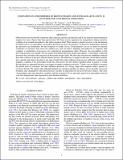Files in this item
Ionisation in atmospheres of Brown Dwarfs and extrasolar planets II Dust-induced collisional ionization
Item metadata
| dc.contributor.author | Helling, Christiane | |
| dc.contributor.author | Jardine, M. | |
| dc.contributor.author | Mokler, F. | |
| dc.date.accessioned | 2014-05-09T13:31:01Z | |
| dc.date.available | 2014-05-09T13:31:01Z | |
| dc.date.issued | 2011-08-10 | |
| dc.identifier | 8932652 | |
| dc.identifier | 045f5922-96f4-4858-a8d6-e859dc5ca05b | |
| dc.identifier | 000293332200038 | |
| dc.identifier | 80052039098 | |
| dc.identifier.citation | Helling , C , Jardine , M & Mokler , F 2011 , ' Ionisation in atmospheres of Brown Dwarfs and extrasolar planets II Dust-induced collisional ionization ' , Astrophysical Journal , vol. 737 , no. 1 , 38 . https://doi.org/10.1088/0004-637X/737/1/38 | en |
| dc.identifier.issn | 0004-637X | |
| dc.identifier.other | BibCode: 2011ApJ...737...38H | |
| dc.identifier.other | ORCID: /0000-0002-1466-5236/work/57821833 | |
| dc.identifier.uri | https://hdl.handle.net/10023/4751 | |
| dc.description.abstract | Observations have shown that continuous radio emission and also sporadic Ha and X-ray emission are prominent in singular, low-mass objects later than spectral class M. These activity signatures are interpreted as being caused by coupling of an ionized atmosphere to the stellar magnetic field. What remains a puzzle, however, is the mechanism by which such a cool atmosphere can produce the necessary level of ionization. At these low temperatures, thermal gas processes are insufficient, but the formation of clouds sets in. Cloud particles can act as seeds for electron avalanches in streamers that ionize the ambient gas, and can lead to lightning and indirectly to magnetic field coupling, a combination of processes also expected for protoplanetary disks. However, the precondition is that the cloud particles are charged. We use results from Drift-Phoenix model atmospheres to investigate collisional processes that can lead to the ionization of dust grains inside clouds. We show that ionization by turbulence-induced dust-dust collisions is the most efficient kinetic process. The efficiency is highest in the inner cloud where particles grow quickly and, hence, the dust-to-gas ratio is high. Dust-dust collisions alone are not sufficient to improve the magnetic coupling of the atmosphere inside the cloud layers, but the charges supplied either on grains or within the gas phase as separated electrons can trigger secondary nonlinear processes. Cosmic rays are likely to increase the global level of ionization, but their influence decreases if a strong, large-scale magnetic field is present as on brown dwarfs. We suggest that although thermal gas ionization declines in objects across the fully convective boundary, dust charging by collisional processes can play an important role in the lowest mass objects. The onset of atmospheric dust may therefore correlate with the anomalous X-ray and radio emission in atmospheres that are cool, but charged more than expected by pure thermal ionization. | |
| dc.format.extent | 11 | |
| dc.format.extent | 694538 | |
| dc.language.iso | eng | |
| dc.relation.ispartof | Astrophysical Journal | en |
| dc.subject | brown dwarfs | en |
| dc.subject | plasmas | en |
| dc.subject | planets and satellites: atmospheres | en |
| dc.subject | stars: atmospheres | en |
| dc.subject | Low-mass stars | en |
| dc.subject | Cloud formation | en |
| dc.subject | Radio-emission | en |
| dc.subject | T-dwarf | en |
| dc.subject | MU-M | en |
| dc.subject | Grains | en |
| dc.subject | Variability | en |
| dc.subject | Models | en |
| dc.subject | TVLM-513-46546 | en |
| dc.subject | Transition | en |
| dc.subject | QB Astronomy | en |
| dc.subject.lcc | QB | en |
| dc.title | Ionisation in atmospheres of Brown Dwarfs and extrasolar planets II Dust-induced collisional ionization | en |
| dc.type | Journal article | en |
| dc.contributor.sponsor | Science & Technology Facilities Council | en |
| dc.contributor.sponsor | Science & Technology Facilities Council | en |
| dc.contributor.institution | University of St Andrews. School of Physics and Astronomy | en |
| dc.identifier.doi | https://doi.org/10.1088/0004-637X/737/1/38 | |
| dc.description.status | Peer reviewed | en |
| dc.identifier.url | http://adsabs.harvard.edu/abs/2011arXiv1105.4409H | en |
| dc.identifier.grantnumber | ST G001987 1 | en |
| dc.identifier.grantnumber | ST G001987 1 | en |
This item appears in the following Collection(s)
Items in the St Andrews Research Repository are protected by copyright, with all rights reserved, unless otherwise indicated.

